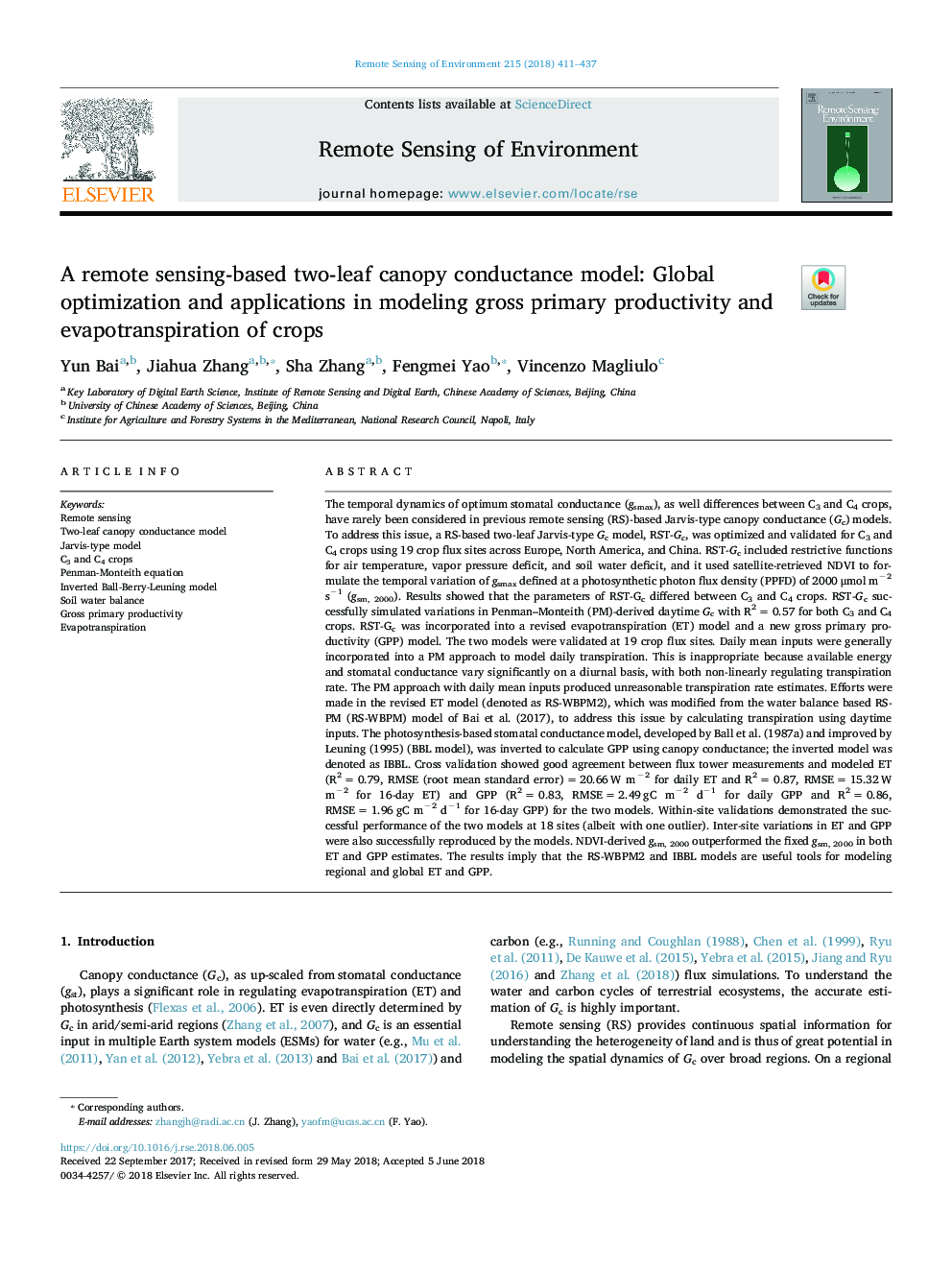| کد مقاله | کد نشریه | سال انتشار | مقاله انگلیسی | نسخه تمام متن |
|---|---|---|---|---|
| 8866485 | 1621185 | 2018 | 27 صفحه PDF | دانلود رایگان |
عنوان انگلیسی مقاله ISI
A remote sensing-based two-leaf canopy conductance model: Global optimization and applications in modeling gross primary productivity and evapotranspiration of crops
ترجمه فارسی عنوان
یک مدل هدایت پذیری دوطرفه مبتنی بر سنجش از راه دور: بهینه سازی جهانی و کاربرد در مدل سازی بهره وری اولیه و تبخیر تعرق محصولات
دانلود مقاله + سفارش ترجمه
دانلود مقاله ISI انگلیسی
رایگان برای ایرانیان
کلمات کلیدی
موضوعات مرتبط
مهندسی و علوم پایه
علوم زمین و سیارات
کامپیوتر در علوم زمین
چکیده انگلیسی
The temporal dynamics of optimumâ¯stomatal conductance (gsmax), as well differences between C3 and C4 crops, have rarely been considered in previous remote sensing (RS)-based Jarvis-type canopy conductance (Gc) models. To address this issue, a RS-based two-leaf Jarvis-type Gc model, RST-Gc, was optimized and validated for C3 and C4 crops using 19 crop flux sites across Europe, North America, and China. RST-Gc included restrictive functions for air temperature, vapor pressure deficit, and soil water deficit, and it used satellite-retrieved NDVI to formulate the temporal variation of gsmax defined at a photosynthetic photon flux density (PPFD) of 2000â¯Î¼mol mâ2 sâ1 (gsm, 2000). Results showed that the parameters of RST-Gc differed between C3 and C4 crops. RST-Gc successfully simulated variations in Penman-Monteith (PM)-derived daytime Gc with R2â¯=â¯0.57 for both C3 and C4 crops. RST-Gc was incorporated into a revised evapotranspiration (ET) model and a new gross primary productivity (GPP) model. The two models were validated at 19 crop flux sites. Daily mean inputs were generally incorporated into a PM approach to model daily transpiration. This is inappropriate because available energy and stomatal conductance vary significantly on a diurnal basis, with both non-linearly regulating transpiration rate. The PM approach with daily mean inputs produced unreasonable transpiration rate estimates. Efforts were made in the revised ET model (denoted as RS-WBPM2), which wasâ¯modified from the water balance based RS-PM (RS-WBPM) model of Bai et al. (2017), to address this issue by calculating transpiration using daytime inputs. The photosynthesis-based stomatal conductance model, developed by Ball et al. (1987a) and improved by Leuning (1995) (BBL model), was inverted to calculate GPP using canopy conductance; the inverted model was denoted as IBBL. Cross validation showed good agreement between flux tower measurements and modeled ET (R2â¯=â¯0.79, RMSE (root mean standard error)â¯=â¯20.66â¯W mâ2 for daily ET and R2â¯=â¯0.87, RMSEâ¯=â¯15.32â¯W mâ2 for 16-day ET) and GPP (R2â¯=â¯0.83, RMSEâ¯=â¯2.49â¯gC mâ2 dâ1 for daily GPP and R2â¯=â¯0.86, RMSEâ¯=â¯1.96â¯gC mâ2 dâ1 for 16-day GPP) for the two models. Within-site validations demonstrated the successful performance of the two models at 18 sites (albeit with one outlier). Inter-site variations in ET and GPP were also successfully reproduced by the models. NDVI-derived gsm, 2000 outperformed the fixed gsm, 2000 in both ET and GPP estimates. The results imply that the RS-WBPM2 and IBBL models are useful tools for modeling regional and global ET and GPP.
ناشر
Database: Elsevier - ScienceDirect (ساینس دایرکت)
Journal: Remote Sensing of Environment - Volume 215, 15 September 2018, Pages 411-437
Journal: Remote Sensing of Environment - Volume 215, 15 September 2018, Pages 411-437
نویسندگان
Yun Bai, Jiahua Zhang, Sha Zhang, Fengmei Yao, Vincenzo Magliulo,
